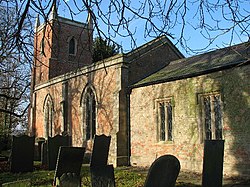Flawborough
| Flawborough | |
| Nottinghamshire | |
|---|---|
 Church of St Peter, Flawborough | |
| Location | |
| Grid reference: | SK783429 |
| Location: | 52°58’39"N, -0°50’8"W |
| Data | |
| Population: | 307 (2011; with Sibthorpe) |
| Post town: | Nottingham |
| Postcode: | NG13 |
| Local Government | |
| Council: | Rushcliffe |
| Parliamentary constituency: |
Rushcliffe |
Flawborough is a small hamlet in the east of Nottinghamshire, found seven miles south of Newark-on-Trent, at the northern tip of the Vale of Belvoir. Alverton is half a mile to the east, and Shelton is a mile to the north.
Comprising mainly farmland, this linear village has a single primary road through its centre (Main Street)[1] and one minor (Shelton Lane). It is approached along the crest of a hill from its southern boundary by Longhedge Lane, and the farmland falls away to its western boundary, the River Smite. This is a deep channel, with normally only 12 inches of water, but as it is the Vale of Belvoir's “drain” it can rapidly rise over twenty feet and flood.[2] At the northern tip of the parish, the River Smite joins the River Devon, also from the Vale of Belvoir.
There is evidence of old quarry workings in the east of the parish.
History
Key buildings include the unused Grade II listed, nineteenth century rebuilt Church of St Peter,[1] and Flawborough Hall.
Flawborough Hall was once owned by Major Edward Harold Spalding, a partner in the Griffin & Spalding department store in the Old Market Square of Nottingham. The business was subsequently bought out by and rebranded to Debenhams. Spalding later became the Sheriff of Nottinghamshire in 1951.[3] The Hall is now the operating premises for a local farm.
Dallington was a nearby tiny community but by the nineteenth century was virtually deserted and considered to be a lost village.[4] Both it and Flawborough were notable enough to be recorded in the Domesday Book.[5]
The wider area at the turn of the century was held by the Duke of Newcastle who was Lord of the manor and sole landowner.[5]
References
- ↑ 1.0 1.1 National Heritage List 1272725: Church Of St Peter, Flawborough (Grade II listing)
- ↑ "History | Flawborough Farms" (in en-GB). https://www.flawboroughfarms.co.uk/4/History.
- ↑ "No. 39175". The London Gazette. 16 March 1951. p. 1428.". https://www.thegazette.co.uk/London/issue/39175/page/1428.
- ↑ Sites (www.communitysites.co.uk), Community. "Lost village | Dallington | Notts Places | Our Nottinghamshire". http://www.ournottinghamshire.org.uk/page/dallington?path=0p2p203p.
- ↑ 5.0 5.1 Information on Flawborough from GENUKI